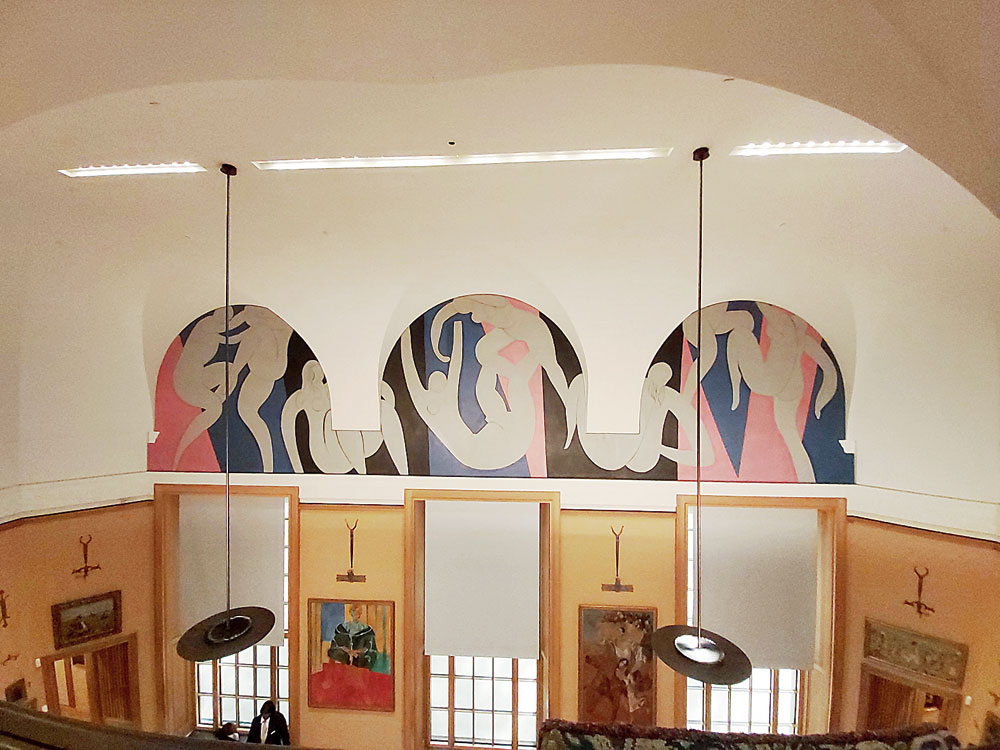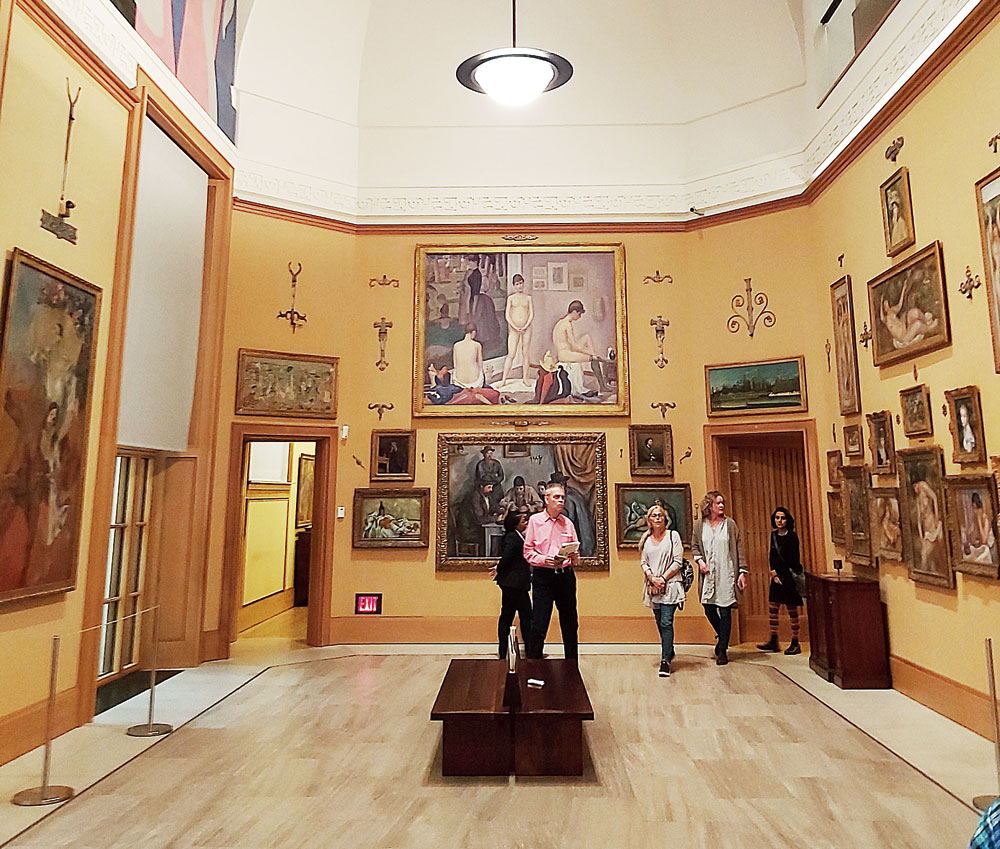The inception
Barnes is home to an unforgettable collection of impressionist, post-impressionist and early modernist paintings. It was created by just one man, a self-made man, who was born into a working-class family in Philadelphia in 1872. A 1926 portrait (by Giorgio de Chirico) of the chemist, businessman, educator and art collector greets visitors.
After working (he found support by playing semi-professional baseball) his way through medical school at the University of Pennsylvania, he developed Argyrol, a silver nitrate antiseptic which was used to treat ophthalmic infections among babies. Success followed and so did money. He could have practised as a physician but decided to follow a different path after completing his medical internship. He had the good luck to sell this company out to a big pharmaceutical firm in July-August 1929, just a couple of months before the big stock exchange crash. He reportedly walked away with $6 million back then.
But his painting collection started much earlier, in 1912, purely as a hobby. Though he had no training or art history background, he sent his high school friend William Glackens to Paris in February 1912 with only $20,000 (which would now be around $400,000) to buy some examples of modern art, which he was reading about. This was at a time when Paris was at the centre of the art world, where all the innovations were happening. Picasso was there. Matisse was there. Artists from all over the world had descended on Paris where they lived freely, painting what they wanted to paint.
Glackens met dealers and artists like Picasso. He bought 33 paintings. These were by Renoir, Cezanne, Picasso, Degas, Pissarro… you get the idea. That was the beginning of the collection, one of the showpieces is Matisse’s 45-foot-long triptych mural, The Dance II, which Barnes had commissioned for $30,000. They were to be placed in the three round-headed arches of the main gallery, positioned above a trio of French doors. Featuring geometric shards of blue and pink, the work has a group of grey nudes springing upwards and tumbling down.
Barnes looked at the paintings Glackens had brought back and found them so interesting that he decided to visit Paris himself. He met Picasso and bought more paintings from him. The man had no curator, advisor or expert. He bought what he liked. Up until the day he died in 1951, he was always buying, trading and swapping paintings. It was a very fluid collection.

Giorgio de Chirico’s 1926 portrait of Albert C. Barnes Image: The Telegraph
The poet T.S. Eliot wanted to visit the Barnes Foundation in Philadelphia where Cezannes, Renoirs and Picassos live together on the many walls. The visionary collector Albert C. Barnes had a one-word response to the note that had been put in: “Nuts,” which, we believe, was a no. His eccentricity lingers in the new building — by architects Tod Williams and Billie Tsien — that opened in 2012. Right in the heart of the City of Brotherly Love is an address that’s at once world famous and also a secret to many. Inside are 181 Pierre-Auguste Renoirs, 69 Paul Cezanne creations, 46 Pablo Picasso paintings, 59 Henri Matisses and much, so much more.
Originally he had built a mansion to house his collection in the Philadelphia suburb of Merion where explanatory texts on the walls and catalogues were greeted with disdain. He believed in visual literacy over textual education. The Barnes Foundation, the holder of the collection, finally managed to move to a new centre. The Merion building and its many galleries, complete with Barnes’s arrangements within them, have been replicated at the new address, complete with the same window placements and the countless wrought-iron hinges, locks and whatnot that speckle the walls. The paintings are hung exactly as they were the day he died in 1951.

One of the showpieces is Matisse’s 45-foot-long triptych mural, The Dance II, which Barnes had commissioned for $30,000 Image: The Telegraph

Paul Cezanne’s The Card Players Picture courtesy: Barnes Foundation
A blackboard for one’s thoughts
Inspired by the writings of philosopher John Dewey, who emphasised the importance of education in a truly democratic society, Barnes, in 1922, chartered the Foundation as an educational institution for teaching people how to look at art. He wanted people to learn about art by looking at them instead of being told what to look for. The paintings in the galleries are not in any sequence; they are stacked floor to ceiling. If you go to a stately home in England or France, this is what you will get. It’s called the salon style. He mixes everything up — culture, traditions, artists and time periods. This was done because he believed that no artist learns in a vacuum; they learn from what they see around them, on the streets and at home.
At the gallery, there is nothing to read on the walls. Usually, at an art gallery, most people first read the text on the walls. Some, in fact, spend more time reading the text than looking at what’s on the wall. At the Philadelphia address one has no choice but to look and make connections. Each wall is like a blackboard. Feel free to scribble your thoughts with an invisible chalk. Visual education was his mission.
When he had his factory, most employees were African-American women with no education. Barnes arranged their days in a way that each of them had at least two hours free during which they would read poetry, listen to classical music and discuss philosophy. He would bring paintings to the factory floor where they could discuss them.
The idea has always been to make the viewer comfortable admiring a painting instead of worrying about what others may think of it. Barnes also wanted people to understand how paintings are constructed. What we look at is a flat piece of canvas with paint on it. When the artist applies paint using lines, light, colour, space and geometry, a sense of emotion comes through.
For example, take a look at Paul Cezanne’s The Card Players which is one of the famous pieces housed here. The main player in the painting has a white shirt on and the way his hands are drawn forms a pyramid. Next, look at the ‘V’ shape the posture of the legs give rise to, as if there is an inverted pyramid. Together, a diamond shape comes through, in the middle of which are the playing cards. To draw our attention to the cards, there is a white pipe that sticks out as if it can be taken off the table; it’s almost 3D and it almost leads one’s eye to the focal point of the painting. The interpretation changes with the viewer. Another unique way of drawing our eyes to the paintings are metal hinges in all shapes and sizes that adorn the walls.
What Albert C. Barnes had done almost a century ago is now being discussed by other institutions, including the Museum of Modern Art in New York — the idea about rearranging collections to mix things up.
At this centre of art education, surprises are endless, making it an endearing stop for anyone visiting Philadelphia for a couple of days. This eclectic collection, displayed unusually, indeed showcases that Barnes’s legacy is a treasure for all.

Barnes, in 1922, chartered the Foundation as an educational institution for teaching people how to look at art Image: The Telegraph










